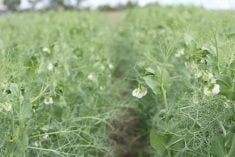Some parts are too wet and others too dry, but overall the Canadian prairie spring crop looks average, the Canadian Wheat Board says.
Cool weather has slowed crop development, but not to a dangerous degree.
“That’s not a particularly big deal unless it continues into mid-July,” said CWB weather analyst Bruce Burnett in an interview after the board’s briefing of summer world weather.
“If we had a couple of weeks, a block of a week or two of hotter than average temperatures,” prairie crops would catch up, said Burnett.
Read Also

Phosphate prices to remain high
Phosphate prices are expected to remain elevated, according to Mosaic’s president.
Some parts of Manitoba and eastern Saskatchewan are sodden, with delayed seeding and flooding because of repeated heavy rains. A wide belt that runs from west of Coronation, Alta., to east of Kindersley, Sask., is still dry, hampering crop development there.
Cooler than average temperatures have held crops back. Burnett said May and early June temperatures were two to four degrees colder than normal. The eastern Prairies were particularly cool, with most areas receiving only 50-75 percent of normal heat units. Temperatures have been better in the western Prairies, which have received 75 to 100 percent of normal heat units.
The wheat board is estimating a prairie wheat and durum crop of 22.1 million tonnes this summer, up from last summer’s 21.1 million tonnes.
The durum crop is expected to reach 4.7 million tonnes, up from 4.3 million in 2003.
Barley should also be slightly higher, with 11.9 million tonnes this summer compared to 11.4 million last summer. But last year at this time the yield outlook looked better because timely rains had brought sufficient but not excessive moisture to most areas.
“The prospects this year look a little dimmer because we have drier soils in western Saskatchewan and eastern Alberta,” said Burnett.
The board is predicting average wheat yields of about 33 bushels per acre, durum yields of slightly more than 30 bu. per acre and barley yields of about 54 bu.
The board is also predicting likely crops of 6.9 million tonnes of canola, one million tonnes of flax and 3.4 million tonnes of oats. Those are also slightly more than harvested in 2003.















